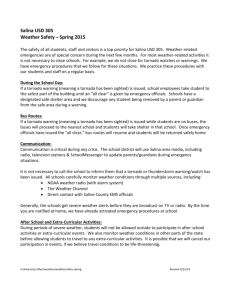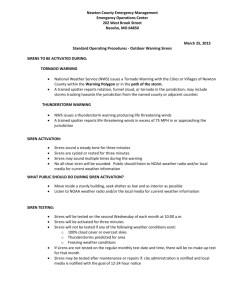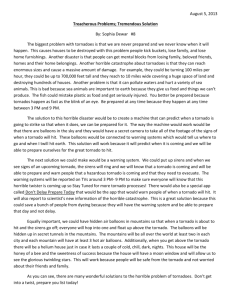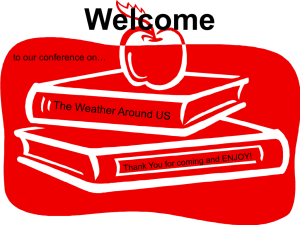WEATHER ANNEX - City of Lawrenceville, Illinois
advertisement
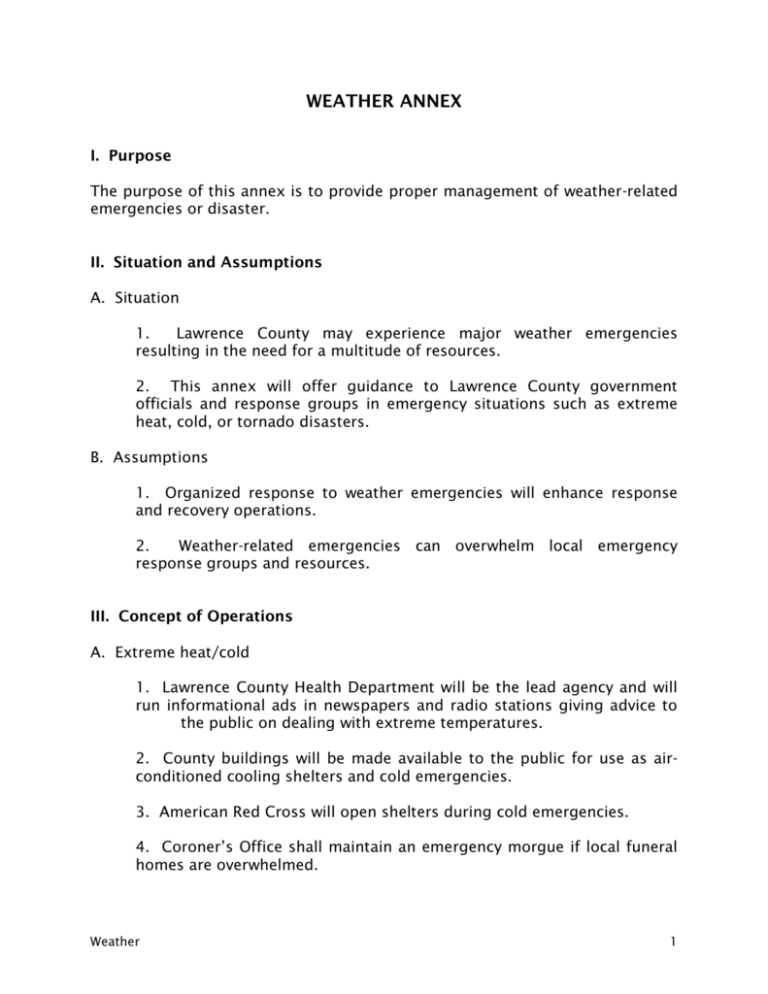
WEATHER ANNEX I. Purpose The purpose of this annex is to provide proper management of weather-related emergencies or disaster. II. Situation and Assumptions A. Situation 1. Lawrence County may experience major weather emergencies resulting in the need for a multitude of resources. 2. This annex will offer guidance to Lawrence County government officials and response groups in emergency situations such as extreme heat, cold, or tornado disasters. B. Assumptions 1. Organized response to weather emergencies will enhance response and recovery operations. 2. Weather-related emergencies can overwhelm local emergency response groups and resources. III. Concept of Operations A. Extreme heat/cold 1. Lawrence County Health Department will be the lead agency and will run informational ads in newspapers and radio stations giving advice to the public on dealing with extreme temperatures. 2. County buildings will be made available to the public for use as airconditioned cooling shelters and cold emergencies. 3. American Red Cross will open shelters during cold emergencies. 4. Coroner’s Office shall maintain an emergency morgue if local funeral homes are overwhelmed. Weather 1 5. Lawrence County Emergency Management Agency (EMA) will provide access to local, county, state and federal resources. 6. Decision for opening cold/heat shelters will be made by a consensus of the county health department, EMA, and Red Cross. B. Tornado emergencies 1. Lawrence County EMA will be the lead agency and will coordinate weather spotting, warning, and damage assessment. 2. Red Cross will assist in shelter management and damage assessment. 3. Law Enforcement will assist in weather spotting and perimeter control. 4. Fire Departments will assist in weather spotting, rescue. 5. Amateur Radio will assist in weather spotting. IV. Organization and Assignment of Responsibilities A. Lawrence County Health Department will: 1. Distribute heat/cold safety warnings and survival tips utilizing the media. 2. Regularly inspect public buildings and shelters during the heat/cold emergency. 3. Provide health care for occupants of public buildings and shelters. B. Lawrence County EMA will: 1. Provide communications for public/private buildings used as shelters. 2. Access any resources needed to respond to a heat/cold/tornado emergency. 3. Coordinate weather spotters. 4. Notify proper authorities of tornadoes/funnel clouds. (See Appendix A.) 5. Authorize activation of warning sirens. (See Appendix B.) Weather 2 6. Supply Damage Assessment Team (DAT) to disaster area. 7. Supply communications if necessary to any responding group. 8. Active the Emergency Operations Center (EOC), less decision-makers, when a tornado watch, if severe weather is imminent, or warning is issued by the National Weather Service. 9. EMA and ham radio operators shall display a flashing amber light while weather spotting in unincorporated/rural areas. C. Lawrence Coroner will: 1. Maintain a list of all victims taken to any county funeral home or emergency morgue. 2. Release names of victims. 3. Act as public information office (PIO) during the emergency. D. Fire Departments will: 1. Check homes in their jurisdiction for victims of heat/cold emergencies. 2. Assist in weather spotting. 3. Aid in search and rescue of tornado victims. 4. Activate weather warning sirens. (See Appendix B.) E. The 911 Centers will: 1. Will initiate activation of weather warning sirens. (See appendix B.) F. North Knox Chapter of the American Red Cross will: 1. Operate and maintain shelters. 2. Supply Damage Assessment Team (DAT) to the disaster area. Weather 3 3. Supply water/refreshments to emergency response groups responding to disasters. 4. Act as liaison to American Red Cross disaster services. V. Succession of Command A. The line of succession for the Health Department will be: 1. County Health Department Administrator 2. Assistant County Health Department Administrator. 3. Designee of the County Health Department Administrator. B. The line of succession for Lawrence County EMA will be: 1. EMA Director 2. Assistant EMA Director 3. Office Manager VI. Development and Maintenance A. The responsibility for revisions, keeping attachments current, and developing necessary documents for the annex belongs to EMA. B. The responsibility for revisions and maintaining SOPs belong to EMA and the county health department. Weather 4 VII. Authorities and References The Robert T. Stafford Disaster Relief and Emergency Assistance Act, as amended 42 U.S.C. 5121 et seq. The Illinois Emergency Management Act (20 ILCS 3305). County Ordinance relating to Emergency Management as adopted by the Lawrence County Board on April 8, 2005. Guide for All-Hazard Emergency Operations Planning: State and Local Guide (101); FEMA April 2001. VIII. Appendices A. Call List in the Event of a Tornado B. Sirens Criteria C. Recovery Operations Checklist D. Fujita Tornado Damage Scale E. Enhanced F Scale for Tornado Damage Weather 5 Appendix A Call List in the Event of a Tornado 1. Log: time location direction speed aloft or on ground who called it in (weather spotter’s number) 2. Call the affected Fire Department 3. Call the affected School Superintendent 4. Call the National Weather Service: 1-800-611-4570 5. Call the Lawrence County Sheriff: (217) 342-2101 6. Call Lawrence County Memorial Hospital (if in jeopardy): (217) 347-2121 (dial “0" at prompt.) Call them back when all clear. 7. Notify all weather spotters via Ham and EMA radio 8. Notify all Fire Departments via 154.43 9. Call State EOC: 1-800-782-7860 or 54.44 MHZ or 155.025 MHz 10. If tornado damage occurs, call: Charles Gillespie, County Board Chair Home: (618) 943-3075 Gene Hays, EMA Chairman Home: (618) 928-8815 Weather 6 Appendix B Sirens Criteria 1. EMA, the two 911 PSAPs and the local Fire Departments are authorized to activate the warning sirens. Lawrenceville Police Chief is authorized to activate city sirens. 2. The Lawrence County PSAPs will alternate testing the sirens on the first Tuesday of each month at 10:00 a.m. If local Fire Departments wish to test their activation system, they are to notify the PSAPs first. 3. The PSAPs will notify the radio stations, Mayor’s office, and others as they deem necessary before testing the sirens. 4. Sirens will be activated when: a) The National Weather Service issues a tornado warning. If the National Weather Service issues a warning for the entire county, all sirens will be activated. If a warning is issued for a particular area or town, only the sirens in that affected area will be activated. b) A weather spotter, firefighter, or law enforcement officer sights a tornado or funnel cloud. Only the sirens in the immediate area of the sighting and in the projected path will be activated. The projected path will be determined by the observer and the activating entity. c) The National Weather Service issues a wind speed warning in excess of 75 mph or greater. 6. A steady tone will be sounded for approximately three minutes for warning. No all clear will be sounded. 7. In the event that a weather spotter, firefighter, or law enforcement officer disagrees on a sighting, the National Weather Service trained weather spotter, firefighter, or law enforcement officer shall prevail over the untrained. Weather 7 Appendix C Recovery Operations Checklist 1. Continue to provide welfare assistance to victims, if necessary. 2. Continue to provide welfare service information to victims, if necessary. 3. Assess long term welfare needs of victims. 4. Coordinate opening Disaster Assistance Centers, if necessary, with state and federal government officials. 5. Release personnel and organizations no longer needed. 6. Support cleanup and recovery of welfare operations during disaster events. Weather 8 Appendix D Fujita Tornado Damage Scale Dr. T. Theodore Fujita developed a damage scale (Fujita 1971, Fujita and Pearson 1973) for winds, including tornadoes, which is supposed to relate the degree of damage to the intensity of the wind. The F-scale should be used with great caution. Tornado wind speeds are still largely unknown; and the wind speeds on the F-scale have never been scientifically tested and proved. Different winds may be needed to cause the same damage depending on how well built a structure is, wind direction, wind duration, battering by flying debris, and many other factors. In addition, the process of rating the damage itself is largely a judgment call – quite inconsistent and arbitrary (Doswell and Burgess, 1988). Even meteorologists and engineers highly experienced in damage survey techniques may come up with different F-scale ratings for the same damage. Even with all its flaws, the F-scale is the only widely used tornado rating method, and probably will remain so until ground-level winds can be measured in most tornadoes. (Source: NOAA, NCEP) SCALE WIND ESTIMATE ***(MPH) F0 < 73 F1 73-112 F2 113-157 F3 158-206 F4 207-260 F5 261-318 TYPICAL DAMAGE Light damage: Some damage to chimneys; branches broken off trees; shallow-rooted trees pushed over; sign boards damaged. Moderate damage: Peels surface off roofs; mobile homes pushed off foundations or overturned; moving cars blown off roads. Considerable damage: Roofs torn off frame houses; mobile homes demolished; boxcars overturned; large trees snapped or uprooted; light-object missiles generated; cars lifted off ground. Severe damage: Roofs and some walls torn off well-constructed houses; trains overturned; most trees in forest uprooted; heavy cars lifted off the ground and thrown. Devastating damage: Well-constructed houses leveled; structures with weak foundations blown away some distance; cars thrown and large missiles generated. Incredible damage: Strong frame houses leveled off foundations and swept away; automobile-sized missiles fly through the air in excess of 100 meters (109) yards); trees debarked; incredible phenomena will occur. ***IMPORTANT NOTE ABOUT F-SCALE WINDS: Do not use F-scale winds literally. These precise wind speed numbers are actually guesses and have never been scientifically verified. Different wind speeds may cause similar-looking damage from place to place – even from building to building. Without a thorough engineering analysis of tornado damage in any event, the actual wind speeds needed to cause that damage are unknown. Weather 9 Appendix E Enhanced F Scale for Tornado Damage An update to the the original F-scale by a team of meteorologists and wind engineers, to be implemented in the U.S. on 1 February 2007. DERIVED SCALE FUJITA SCALE EF OPERATIONAL EF SCALE Fastest F 1/4Number mile (mph) 3 Second Gust (mph) 3 EF Second Number Gust (mph) 3 EF Second Number Gust (mph) 0 40-72 45-78 0 65-85 0 65-85 1 73-112 79-117 1 86-109 1 86-110 2 113157 118161 2 110137 2 111135 3 158207 162209 3 138167 3 136165 4 208260 210261 4 168199 4 166200 5 261318 262317 5 200234 5 Over 200 *** IMPORTANT NOTE ABOUT ENHANCED F-SCALE WINDS: The Enhanced F-scale still is a set of wind estimates (not measurements) based on damage. Its uses three-second gusts estimated at the point of damage based on a judgment of 8 levels of damage to the 28 indicators listed below. These estimates vary with height and exposure. Important: The 3 second gust is not the same wind as in standard surface observations. Standard measurements are taken by weather stations in open exposures, using a directly measured, "one minute mile" speed. Weather 10
